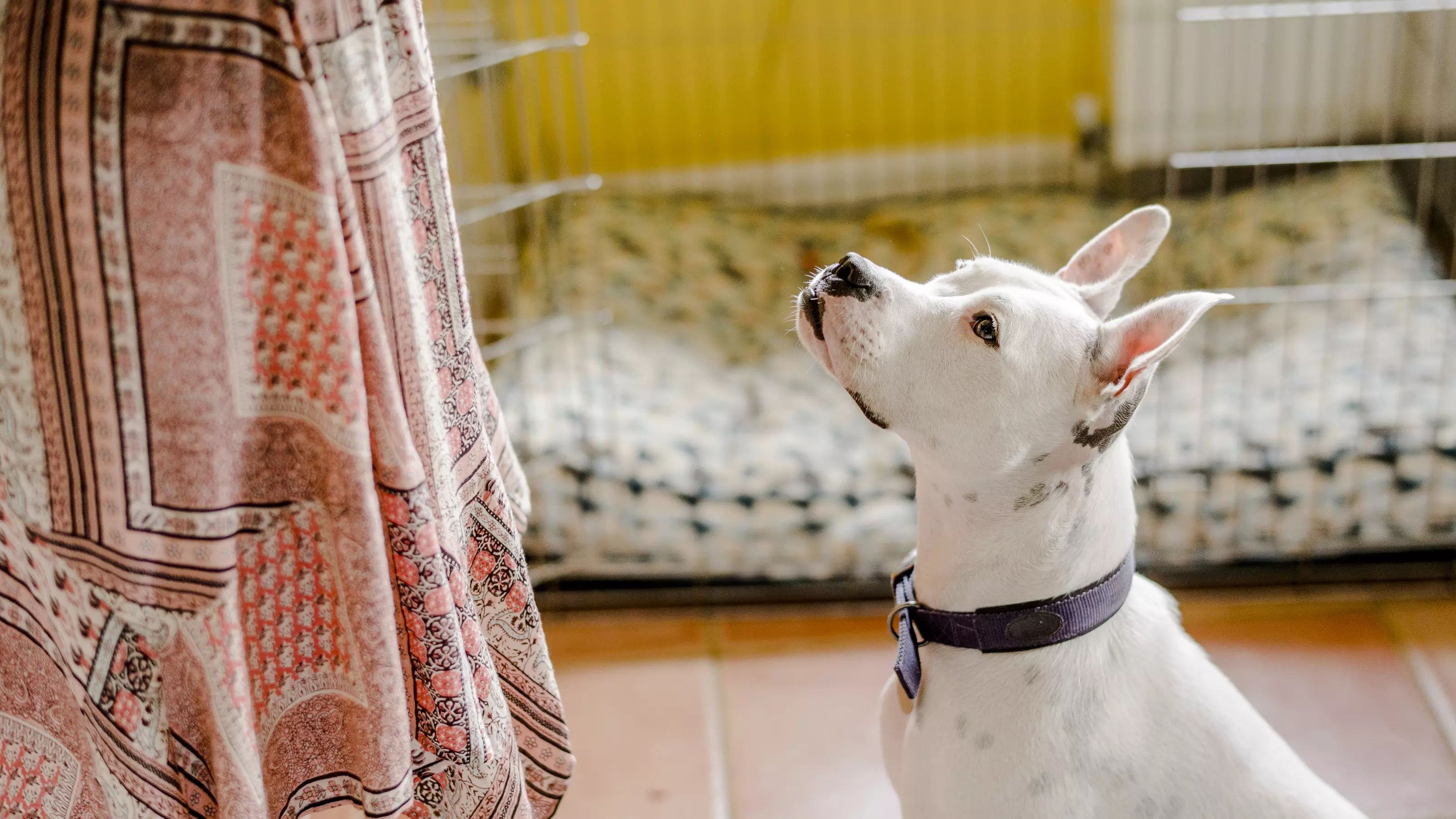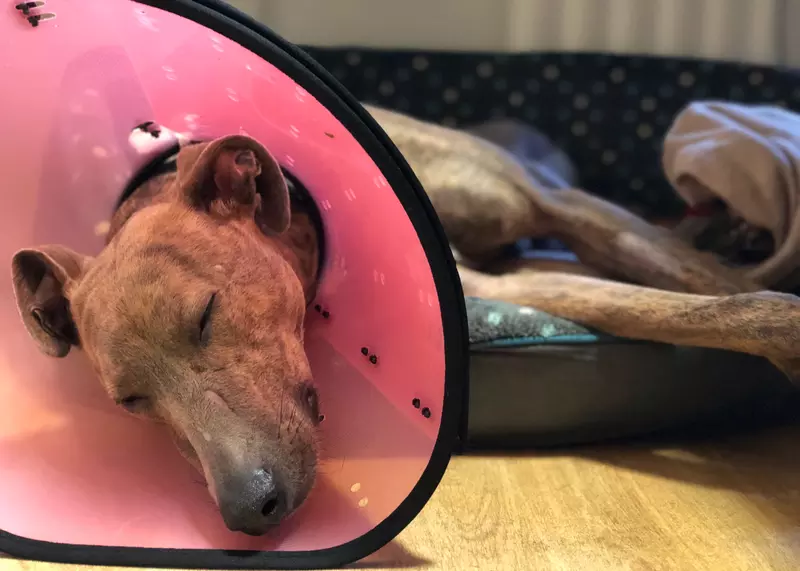
Cage rest for dogs
- Always follow the vet’s instructions on exercise allowance
- Peace and quiet is very important to ensure your dog doesn’t get excited
- Training is a great way to keep your dog occupied and mentally stimulated
- Following a daily routine will help your dog quickly adjust to bed rest
If your dog is unable to go for a walk for health reasons or they’re only allowed out on short walks, there are still lots of things you can do inside the home to tire your dog out and keep them mentally stimulated.
Interacting with your dog a few times through the day can stop them from making up their own games, keeping their minds focused from other possible destructive habits and from injuring themselves further.
Dogs on cage rest
Ideally, you should prepare the crate prior to your dog coming home from the vet; if this is not possible then assemble the crate in another room from your dog to reduce noise levels and stress.
With the crate assembled, cover half of it with a blanket or towel so that your dog can choose to seek comfort in a darker space out of sight or be out in the light, where they can see what’s going on.
If you are planning on placing the crate on laminate or wooden flooring then you should place a blanket or mat under the crate. This is to ensure that when your dog steps out of the crate they don’t slip on the flooring. A lining under the crate also provides extra warmth from the cold floor.
Ideally the crate will be in the same room as you throughout the day so that even though your dog is crated, they will still feel a part of the family and be able to enjoy watching you. This helps to prevent loneliness and calm your dog.
While it can be tempting to let your dog out of its crate early due to whining or barking, or perhaps because they look to have recovered, avoid this. It is very important to listen to advice from your vet about how long your dog needs to be on bed rest.
Letting your dog out early can delay the healing process, or hinder it altogether, and it may lead to a greater chance of your dog reinjuring themselves further down the line.
So what can you do with your dog when they’re bound to the confines of a crate? Here are some tips to keep your dog mentally stimulated and calm during this period.
Peace and quiet
The best thing to do for your dog is to make them feel as calm as possible while they’re confined. Ensure their crate is a safe space where they don’t feel stressed or anxious. To help keep them calm we recommend the following:
- Using an Adaptil plug in diffuser, which works by releasing a scent given off by a mother dog when she has puppies, can help relax your dog as they find the smell comforting
- Try to restrict yourself from having family or guests over as this could excite or worry your dog. They may become anxious if they can’t avoid your visitors or frustrated if they can’t greet them, so best to keep things low-key while they are confined.
- It’s worth considering placing a sign on your front door that asks people not to ring the bell or knock but to call you instead
- Your dog can benefit from a calm, gentle massage or TTouch, which involves using gentle circular touches to relax your pet. The massage should be slow with steady pressure, not fast.
- Any talking should be in a calm voice as opposed to the usual high-pitched tones we adopt to excite our dogs
Note
Check with your vet before massaging your dog or using TTouch as there may be certain areas that should be avoided depending on your dog’s injury.
Safety
For the safety of your dog, it’s best to keep their collar on at all times. This prevents your dog bolting out of its cage and running around the house.
Keep your dog as calm as possible when letting them out of their crate. Don’t get excited when you open the crate door and ideally, try to get your dog to sit (see note below) as soon as the crate door opens so that you are able to then place a lead on them calmly.
It is also essential that you place a lead on your pet for walking around the garden to go to the toilet. This is so they don’t get overexcited and break into a run.
Remember:
- Asking your dog to sit will be dependent on their injury and you should ensure that this won’t affect their recovery
- Don’t use flexi-leads as this can encourage your dog to run by giving them more freedom on their terms. You should use a short, standard lead that doesn’t extend or retract.
Routine
Dogs are creatures of habit and this should be no different when they’re on bed rest. Make sure that your dog is being fed at the same time each day and stick to the schedule so they know what to expect.
During the first few days you may notice your dog becoming frustrated and you may be tempted to entertain them because you feel sorry for them.
This period of frustration is completely normal because it is outside their usual routine and it will take a few days for your dog to adjust.
Try not to show that you feel sorry for your dog and don’t overcompensate for their boredom. The cage rest won’t last too long and they will heal quicker if they are calm and don’t get overexcited.
Food
Much like us, your dog will quickly become very bored sitting in one place continuously and it’s important to break up their day by keeping their minds focused elsewhere.
By using their inquisitive nature to your advantage you can keep your dog entertained for lengthy periods of time. It’s best to vary the games from day to day to keep them guessing. You can do things such as:
- Instead of using your dog’s normal food bowl, think about using a Kong or food puzzle to keep them entertained
- Wrap their food in an old newspaper so they have to unwrap it
- Hide their food in old cardboard boxes or cereal boxes (making sure they don’t eat the box!)
- Use a treat mat to hide food in various little pockets and ask your dog to find it
Note
If your dog is excited around food puzzles and Kongs then supervision is advised, ensuring that the game is taken away as soon as the food has gone.
It’s always fun for your dog to have some variety in their treats, so think about mixing up the food in the Kong ie put a small piece of sausage/plain chicken at the bottom, put your pets normal food on top and then coat with a small layer of cheese/marmite/sausage to encourage them to use it.
For a real boredom buster, try freezing the Kong. Chewing and licking is great for soothing your dog and a frozen Kong will keep them entertained for longer.
Tip
Your dog will likely need to eat less food than usual because of the restriction to their exercise.

Training
Training your dog is a great means of keeping them mentally stimulated and is a fantastic way of bonding with your pooch. You can follow this simple training advice to teach them new tricks.
Crate rest for dogs
You should stick to the tricks that require the lowest amount of energy while your dog is on bed rest such as sit, down and leave. You can also teach them to place their nose on your hand through the crate and reward them with a treat, keeping them on their toes.
Short walks/restricted exercise
Once you have the basics in place and your dog is able to move around the house and garden a bit more, you can start to teach your dog more complex things like go to bed and calm exercises such as stay/wait, as long as it doesn’t interfere with the healing process.
Important
All training and exercise is dependent on your dog’s injury and you should always seek advice from your vet beforehand.







